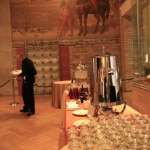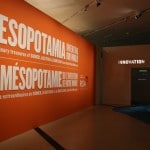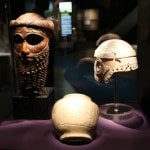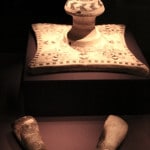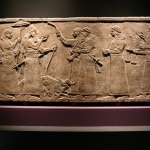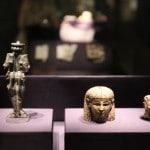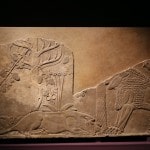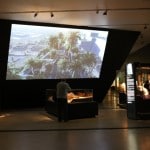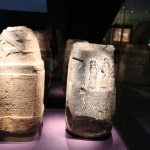The Royal Ontario Museum recently celebrated the launch of its blockbuster summer exhibit, “Mesopotamia: Inventing Our World,” via a press conference and exclusive media preview. I arrived in Yorkville shortly before 9am on a sunny June morning. After checking in with the ROM PR team I was pleased to encounter and indulge in a thoughtfully prepared Mesopotamian inspired brunch featuring olives, hummus and pita, feta, pomegranate, cherries and herb encrusted flat bread.
The press conference featured lively announcements and commentary by ROM CEO Janet Carding, Dr Clemens Reichel (Associate Curator of World Cultures) and Jonathan Tubb (Keeper of the Middle East Department at the British Museum). Once the speeches had finished the crowd spent the next few hours finding inspiration in the ancient as we wound our way through the exhibit. The ROM is the sole Canadian venue to host Mesopotamia during its international tour, which made its North American debut on June 22nd and is on display until January 5th.
Mesopotamia explores over 3,000 years of accomplishments of this ancient civilization to reveal the significance many still have on our lives today. The exhibit features over 170 priceless objects from the esteemed holdings of the British Museum. These artifacts, most of which have never been seen in Canada, are augmented by those from the ROM’s own renowned collections and other leading institutions: University of Chicago’s Oriental Institute Museum, University of Pennsylvania Museum of Archaeology and Anthropology and the Detroit Institute of Arts.
Geographically, Mesopotamia (from the Greek “land between the rivers”) encompasses present-day Iraq, north-eastern Syria and south-eastern Turkey. Urban civilization originated in the area, accompanied by the establishment of the first cities and complex forms of social organization and economic activity. Significant developments during this period include the invention of writing, long-distance communication, trade networks, and the first empires. Sophisticated art and literature began and flourished concurrently with remarkable intellectual, spiritual, and scientific advances. Guests will have an opportunity to discover an interactive exhibit which focuses on the emergence of cities and states in ancient Sumer (4000-2000 BCE); the Assyrian World Empire (1000-600 BCE); and the rise and fall of Babylon (600-540 BCE).
Highlights of the exhibit not to be missed
- The Ram in the Thicket: an exquisitely modeled figure of a rearing goat made of gold, silver, lapus lazuli and shell dating to 2500 BCE
- Jewellery of gold and other precious materials discovered in a series of Royal Tombs predating Egypt’s King Tut by more than a thousand years
- Statue of Ashurnasirpal II, an imposing figure and a rare surviving example of Assyrian sculpture
- Tablet from the Epic of Gilgamesh, one of the longest pieces of literature in Akkadian (the language of Babylon and Assyria)
And so this summer, fall and winter locals and tourists alike will find inspiration at Toronto’s Royal Ontario Museum. The Meso exhibit allows us all to take a break from the hustle and bustle of our contemporary North American city and throw ourselves back in time where we are encouraged to explore a different way of life and find inspiration through the artifacts and ideas these ancient people left behind.


